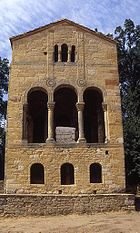
Spanish Pre-Romanesque art
Encyclopedia

Iberian Peninsula
The Iberian Peninsula , sometimes called Iberia, is located in the extreme southwest of Europe and includes the modern-day sovereign states of Spain, Portugal and Andorra, as well as the British Overseas Territory of Gibraltar...
(in Spanish
Spanish language
Spanish , also known as Castilian , is a Romance language in the Ibero-Romance group that evolved from several languages and dialects in central-northern Iberia around the 9th century and gradually spread with the expansion of the Kingdom of Castile into central and southern Iberia during the...
, arte prerrománico; in Portuguese
Portuguese language
Portuguese is a Romance language that arose in the medieval Kingdom of Galicia, nowadays Galicia and Northern Portugal. The southern part of the Kingdom of Galicia became independent as the County of Portugal in 1095...
, arte pré-românica) refers to the art of Spain and Portugal after the Classical Age
Classical antiquity
Classical antiquity is a broad term for a long period of cultural history centered on the Mediterranean Sea, comprising the interlocking civilizations of ancient Greece and ancient Rome, collectively known as the Greco-Roman world...
and before Romanesque art
Romanesque art
Romanesque art refers to the art of Western Europe from approximately 1000 AD to the rise of the Gothic style in the 13th century, or later, depending on region. The preceding period is increasingly known as the Pre-Romanesque...
and architecture
Romanesque architecture
Romanesque architecture is an architectural style of Medieval Europe characterised by semi-circular arches. There is no consensus for the beginning date of the Romanesque architecture, with proposals ranging from the 6th to the 10th century. It developed in the 12th century into the Gothic style,...
; hence the term Pre-Romanesque.
Visigothic art
Visigothic art
The Visigoths entered Hispania in 415, and they rose to be the dominant people there until the Moorish invasion of 711 brought their kingdom to an end.This period in Iberian art is dominated by their style...
, the art of the Visigoths to 711, is usually classified as Migration Period art
Migration Period art
Migration Period art denotes the artwork of the Germanic peoples during the Migration period . It includes the Migration art of the Germanic tribes on the continent, as well the start of the Insular art or Hiberno-Saxon art of the Anglo-Saxon and Celtic fusion in the British Isles...
by art historians to emphasis its Germanic connections and origins; but can also classified as Pre-Romanesque, particularly in Spain, to emphasis its lineage in Spanish history.
The main styles (based on chronological and geographic considerations) of the Iberian Pre-Romanesque were:
- Visigothic artVisigothic artThe Visigoths entered Hispania in 415, and they rose to be the dominant people there until the Moorish invasion of 711 brought their kingdom to an end.This period in Iberian art is dominated by their style...
- Asturian artAsturian artPre-Romanesque architecture in Asturias is framed between the years 711 and 910, the period of the rise, extension and disappearance of the kingdom of Asturias.-Historical introduction:...
, the art of the Kingdom of AsturiasKingdom of AsturiasThe Kingdom of Asturias was a Kingdom in the Iberian peninsula founded in 718 by Visigothic nobles under the leadership of Pelagius of Asturias. It was the first Christian political entity established following the collapse of the Visigothic kingdom after Islamic conquest of Hispania...
from 718718Year 718 was a common year starting on Saturday of the Julian calendar. The denomination 718 for this year has been used since the early medieval period, when the Anno Domini calendar era became the prevalent method in Europe for naming years.- Europe :* Tervel's reign as monarch of Bulgaria...
through the 10th century - Mozarabic art, art of mixed Arab-Spanish heritage made by the Mozarabs, the Christians under the Islamic rule.
- Repoblación art and architectureRepoblación art and architectureThe designation Art and Architecture of the Repoblación has been applied in recent years to the works, predominantly architectural, carried out in the Christian kingdoms of northern Spain between the end of the 9th and beginning of the 11th centuries...
(Spanish, arte de repoblaciónRepoblaciónThe Repoblación was the ninth-century repopulating of a large region between the River Duero and the Cantabrian Cordillera which had been depopulated in the early years of the Reconquista....
), art on the increasing Christian frontierlands. Most of the formerly called Mozarabic buildings receive nowadays also this denomination.
In Catalonia
Catalonia
Catalonia is an autonomous community in northeastern Spain, with the official status of a "nationality" of Spain. Catalonia comprises four provinces: Barcelona, Girona, Lleida, and Tarragona. Its capital and largest city is Barcelona. Catalonia covers an area of 32,114 km² and has an...
and Aragón
Aragon
Aragon is a modern autonomous community in Spain, coextensive with the medieval Kingdom of Aragon. Located in northeastern Spain, the Aragonese autonomous community comprises three provinces : Huesca, Zaragoza, and Teruel. Its capital is Zaragoza...
, a style ancestral to the Romanesque developed early in parallel with the region of Lombardy
Lombardy
Lombardy is one of the 20 regions of Italy. The capital is Milan. One-sixth of Italy's population lives in Lombardy and about one fifth of Italy's GDP is produced in this region, making it the most populous and richest region in the country and one of the richest in the whole of Europe...
and it has become common to refer the formerly called late Catalan Pre-Romanesque as "first Romanesque
First Romanesque
First Romanesque is the name due to Josep Puig i Cadafalch to refer to the Romanesque art developed in Catalonia since the late 10th century....
" after the suggestions of Josep Puig i Cadafalch
Josep Puig i Cadafalch
Josep Puig i Cadafalch was a Spanish Catalan Modernista architect who designed many significant buildings in Barcelona...
.

